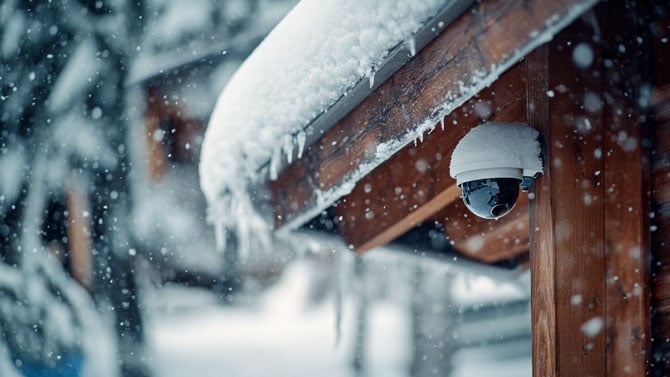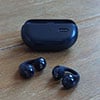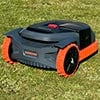Smart home security devices – like video doorbells, security cameras, and outdoor lights – help you keep your home safe. But when temperatures drop, you might find them draining faster, recharging more slowly, or even shutting down completely.

Most battery-powered security cameras, lights, and video doorbells rely on lithium-ion batteries, which function by moving lithium ions between the positive and negative electrodes to generate power. This process relies on chemical reactions that slow down as temperatures drop, making it harder for the battery to supply power efficiently.
You should start paying closer attention to your outdoor gear when temperatures approach freezing. Here's what your devices experience as winter temperatures drop:
- At 32°F (0°C): The battery’s ability to hold a charge decreases, meaning your camera may lose power much faster than usual. Charging also becomes less efficient, taking longer to replenish the battery. This may be especially problematic if the device relies on solar power, which has a slow charging level to begin with.
- Between 14°F and -5°F (-10°C to -20°C): Many lithium-ion batteries enter a protective mode where they stop accepting a charge to prevent damage. Your video doorbell or security camera may temporarily stop functioning.
- Below -5°F (-20°C): The battery may shut down completely, rendering your device non-operational until it warms up again.
If a lithium-ion battery is too cold, charging it could permanently damage its internal structure. At low temperatures, lithium plating can form on the battery’s anode, reducing its capacity and lifespan. This is why most manufacturers recommend bringing a frozen device inside and allowing it to warm up to room temperature before charging.
Read more: How to Keep Your Smart Home from Bogging Down Your Entire Internet
How to Keep Your Home Security and Lighting Working in Cold Weather
1. Charge Your Device Before the Temperature Drops
If you know a cold front is coming and your device has a removable battery, fully charge your products in advance. Once temperatures fall, the battery may drain faster than usual, and recharging it once it’s cold will be more difficult. If the temperature is already nearing freezing, bring your equipment (or just their batteries) inside and let it warm up to room temperature (about 68°F or 20°C) before even plugging in. It’s worth saying again that charging a frozen battery can cause permanent damage by altering its internal chemistry.
2. Optimize Battery Life for Cold Weather
Every time your lights turn on or your security camera sends video to the cloud it is using up battery. So limiting your devices' operations to the basics while you're experiencing a cold snap can prolong their battery life. Here are specific things you can do:
- Reduce Motion Sensitivity: If your camera or doorbell detects motion too frequently, it will drain the battery more quickly. Lower the motion sensitivity in the settings to reduce unnecessary activations.
- Adjust Motion Zones: Narrowing your device’s motion detection area can prevent it from being triggered by cars, pedestrians, or animals outside of your primary monitoring zone.
- Use "Light Traffic" Mode (if available): Some products allow you to set motion detection to a less frequent mode, which can help conserve battery life.
- Turn Off Live View When Not Needed: While Live View is useful for checking in on your property, keeping it on too often will drain the battery. Only use it when necessary.
- Limit Notifications: Frequent push notifications can impact battery life. Adjust your notification settings to only alert you for essential events.
- Reduce Video Recording Length: Shortening video clip lengths (e.g., from 60 seconds to 20 seconds) reduces battery consumption.
- Ensure a Strong WiFi Connection: A weak WiFi signal forces your device to work harder to maintain a connection, draining the battery faster. If your camera frequently disconnects, consider using a WiFi extender.
Read more: How to Get Better WiFi
3. Use Protective Covers and Install in Sheltered Areas
While this won’t completely prevent cold-weather issues, mounting your camera or doorbell in a protected location, such as under the eaves or an awning, can help shield it from wind, snow, and extreme cold. Some third-party manufacturers offer silicone protective covers designed to provide minor insulation, which may help in moderately cold climates
4. Consider Hardwiring
If your video doorbell or security camera has a hardwired power option, it might be time to consider using it. Extreme cold (well below freezing) can still impact use, but a wired device remains fully operational at temperatures that would cause a battery-powered product to shut down.
[Image center: Techlicious/Midjourney]













